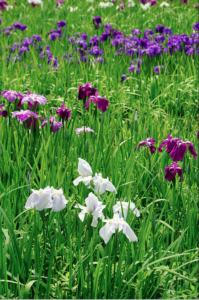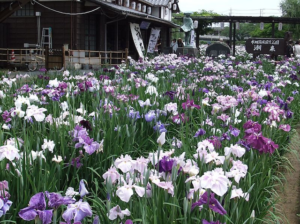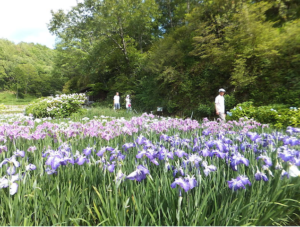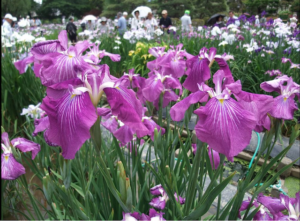Beardless Japanese Iris are Iris Laevigata and Iris Ensata. Referred to there as Kakitsubata and Hana-shobu,respectively, these flowers with their wide, gently cascading petals have long been celebrated in their native country, Japan.
I like this description of the Kakitsubata from Chado: The Way of Tea– “From among the leaves, a long stalk grows with flowers blooming on its head: purple, white, deep blue, deep red and other colors. As it looks like a flying swallow, Chinese characters meaning ‘young-of-a-swallow flower’ are used for its name. It is the flower for the season of fledglings.”
Hana-shobu, Iris ensata, is less dependant on a marshy environment than the Kakitsubata. These iris will grow happily in marshy spots and shallow water ,but the Ensatas can be easily grown in moisture retentive soils on the acid side in part or full sun. Being tall, they would be “back of the border” in mixed plantings.
Apparently the iris has many deep associations in Japan; it is strongly Yin/Yang. The leaves represent man (private part) as well as a sword (bravery, martial feeling), while the flower is woman (private part), while the watery sites on which they grow are “womb and fertility”. Purple colored iris represented amorous passion.
While the flower shape was embroidered or sewed on clothing for charms of bravery and protection ,boys would be bathed in water containing iris leaves to impart the warrior spirit.
The Hachi-ike or “water-vase arrangement” form referred to as Mizu-ike where the holder is put in the water so that the flowers come up out of it often use Iris ensata, water liles and lotus as elements.
Irises
from which that rainbow
rises
~Kobayashi Issa, 1803
- Yagyu Iris Garden in Nara 663Highland
- Maekawa Iris Garden by Tak1701d
- Banshu Yamasaki Iris Garden by Mti
- Iris ensata ‘Horikiri-no-yume’ by Tak1701d






